How To Install A Door Header
How to Frame a New Door Opening
This page covers framing an existing wall to install a new door. Illustrations and instructions include: cut into the wall, planning the frame, and installing a new rex stud. To save fourth dimension and brand installation easier, you should use a pre-hung door for this project. The packaging will have the dimensions for the rough opening and jamb printed on it to make calculations and measurements uncomplicated.
Door Frame Structure
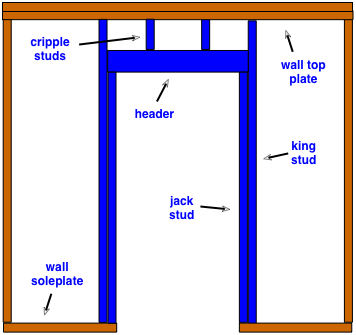
Build a new door frame post-obit the diagram here. The new frame will support the structural load of the wall when the existing supports have been removed.
The parts that come up together to form a door frame include: the cripple studs, which transfer the wall load from the top plate to the door header. The header is supported by the jack and rex studs along the sides where the load is transferred to the soleplate, which in plough transfers the load to the flooring joists and foundation.
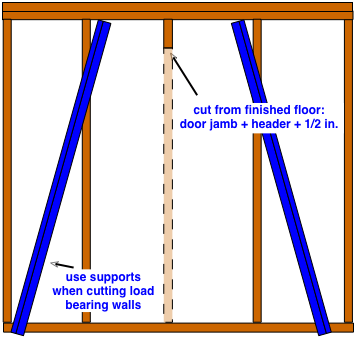
Cutting Into the Wall
To start an opening in an interior wall, first remove the plaster or drywall on both sides of the wall. Leave as much of the original drywall in identify as possible when doing "demo" work to avoid extensive wall repairs later.
With the wall roofing removed, at that place are two choices for removing the existing framing to make room for a new door. i-the studs that fall inside the new opening can be cutting to course the required cripples at the top, or 2-all the framing can be removed and all new pieces installed.
Saving the studs may be the easiest manner simply both methods have their advantages and disadvantages. Removing them completely will mean an easier cutting chore but crave additional framing and wall repair. Preserving them tin make repairing the wall easier just cutting them off straight tin can be difficult.
Saving the Framing
To preserve the cripple studs, calculate where to cut them by adding the jamb height (included in the packaging for pre-hung doors), and the header size (calculated beneath), plus ½inch wiggle room. Remove the plaster or drywall to this point and cutting a direct line across the studs you want to save.
Measure out from the finished floor and utilise a square to mark both faces and edges of the wood. Use a handsaw to cut squarely along the lines to ensure a expert, flush fit against the header yous will be calculation. To avoid binding of the saw blade while you're cut, wedge 2x4's between the flooring and top plate to back up the wall weight. If y'all're working on a load-bearing wall, leave the supports in place until you accept installed all the new framing.
Installing All New Framing
If yous desire to remove the studs completely and install new ones, wedge in the supports under the pinnacle plate and so cut roughly, mid-mode down the wall using a reciprocating saw. Pry the two pieces free from the acme and soleplate being careful at the top to avert breaking a lot of the drywall or plaster off the ceiling.
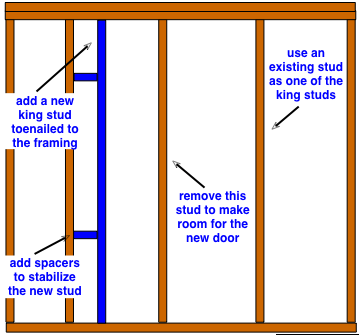
Planning the New Frame
Programme to build your new frame with the jack studs ane inch wider, and the header ½ inch higher than the size of the new door jamb. This extra infinite volition allow for adjusting the position of the new door jamb for a plumb fit.
Choose an existing studs to serve equally the first king stud so determine if it'due south necessary to install a new ane on the other side, or if ane of the studs can exist shimmed to do the job. If y'all tin can't detect two platonic candidates to serve every bit king studs, which is very likely, you'll have to add together a new 2x4 on one side of the new opening.
Locating the New Framing
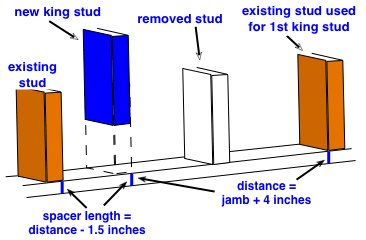
To find the location for the second king stud, add the jamb width, plus 3 inches for jacks, and 1 inch for jerk room. Measure from the inside of the beginning king stud and marker this point on the soleplate. Keep this measurement and utilize information technology again to cut the header length in the next phase of the framing.
If the next existing wall stud is exactly 1½ inches from the mark, yous can just butt a new 2x4 confronting it to act as the 2nd male monarch stud merely most likely things won't exist that simple. If the stud is several inches or more from the mark yous can add together spacers to build out the new 2x4. To cut the spacers, measure to the soleplate marking and decrease 1½ inches (thickness of new 2x4) from this total. Cut ii or three pieces of 2x4 to this length and blast them between the new 2x4 and the existing i.
Shimming a Door Frame
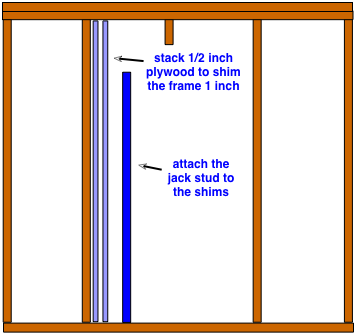
If the stud you want to use is less than 1½ from the marking on the soleplate, you can shim information technology with boards of the appropriate thickness to build it out. For instance, to build out by ane inch, stack 2 pieces of 1/2 plywood so nail the new jack stud to these plywood shims.
If the distance is a little more one½ inches, stack a new 2x4 with the existing one and wedge thin plywood spacers or shim betwixt them to build out to the proper position. The final location tin vary slightly merely endeavour to become within 1/8 inch of the marker for the best results.
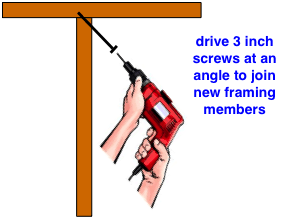
Installing the New Male monarch Stud
Measure from the wall top plate to the soleplate and cut a new 2x4 to this length, then install information technology using two-3 inch deck screws on each end. Bulldoze the screws at an bending to "toenail" it to the plates. Y'all can drill pilot holes get-go to make driving these screws smoother, and improve control. This also makes it easier to reposition in case of error in placement.
If y'all need to use spacers to support the new 2x4, install them get-go before putting the stud in place. Start ane spiral at the top and bottom of the new stud and and so set it in identify so it rests squarely confronting the spacers. Hold the 2x4 in place and drive a screw at each spacers to support it temporarily.
Next, brand sure the new stud is aligned with the mark on the soleplate and bulldoze the bottom screw domicile. Make sure it's plumb using a level held against the side, and so drive the top spiral into the tiptop plate. Finally, drive a second screw at the top and bottom, and at each spacer to finish the installation.

Edifice the Header
The size of the header will vary depending on the size of the new window or door opening. For example, with openings up to 3 feet wide, 2x4's may be used to build the header; for openings upwards to v anxiety, 2x6's should exist used; over five anxiety, use 2x8's.
With the proper size lumber in hand, employ the measurement taken above or add together the width of the jamb, plus 3 inches for jack studs and 1 inch for wiggle room. Cut the lumber for the header to this length. Nail the pieces together with a piece of ½in plywood of the aforementioned size placed between them to create a header the same thickness equally the 2x4 wall framing.
Note: The stated size of lumber is non the actual size, 2x4'south are actually i½in. thick and 3½in. wide. The header sizes here presume lumber of this smaller size in the existing wall. Older houses will have larger framing members, upwards to the bodily 2 past 4 inches. Always measure your framing to be sure.
Installing the Parts
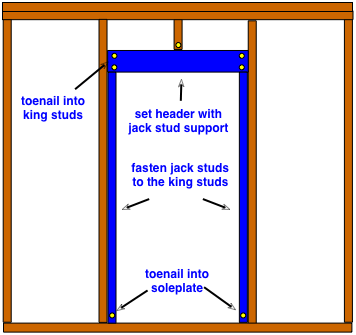
Measure from the top of the header to the lesser of the summit plate, and cut the cripple studs to this length. Install 1 new ane for every 3 feet or less of opening.
Add together the height of the new jamb plus ½inch and cut 2 new jack studs to this length. Slide the assembled header into place butted against the cripples, and wedge the jacks under it for temporary support. Square all the new framing members, and fasten the jacks to the king studs using 3 inch screws, driven at almost 12 inch intervals.
Drive screws, toenailed at an angle, through the cripples and into the top of the header. Also, toenail through the confront of the header and into the kings on both sides of the wall. Finally, toenail through the edge of the jacks and into the soleplate. Make certain none of the screw heads are left protruding so they don't disrupt the installation of new wall cloth and door casings.
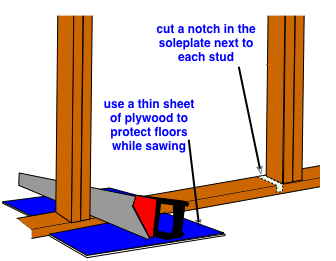
Cut the Soleplate
After the framing has been installed, cut the soleplate to accept the new door. Use a handsaw to cut through the 2x4 plate correct next to the jack studs. Protect floors from the saw blade with a bit slice of plywood or a similar, thin material. Cut the plate, stopping about 1|8in. from the floor, and use a chisel and hammer to finish the job.
Stop with a Chisel
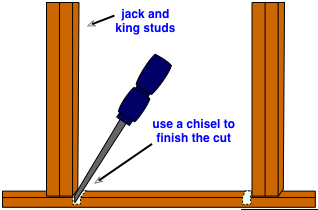
Make a 2nd cut with the saw, about half an inch or more from the studs. Remove the waste to form a aqueduct large enough to use the chisel to cut through the remainder of the soleplate. Pry the loose section of soleplate free from the floor and discard it. With the soleplate removed, the opening is ready for the new pre-hung door.
Afterward the door has been installed, stop the flooring by filling whatsoever holes where the soleplate was with wood putty, and refinish the flooring to match the residual. If the floor is as well rough to refinish, use a threshold saddle to cover it.
In some houses, the interior walls may have been installed before the finished flooring. If this is the case, there will be a gap in the floor where the soleplate was fastened to the sub-floor. Remove the soleplate as described above and fill the gap in the flooring using a piece of woods the same thickness of the finished floor, commonly ¾in for solid woods floors. Cover this rough patch with a saddle molding.
- Framing an Interior Wall
- How to Frame for a New Window
- How to Frame a Door Opening
- Edifice a Door Header
- Demolishing Walls for Remodeling
- Framing to Add a Ceiling Fan
- Building Crown Molding Lighting
- Installing Crown Molding
- Steps to Installing Doors and Windows
- Edifice Radiator Covers
- Installing a Wall Admission Panel
- Installing a Drywall Ceiling
- Wood Joinery Techniques
- Repairing a Window Cord
- Choosing and Installing Wall Anchors
- Lumber and Sheet Materials Guide
- Home Improvement Tool Guide
- Building a Picket Fence
- Pest Proof Garden Fence
- How to Build a Argue
- How to Build an Arbor
- Building Garden Trellises
- Landscape Edge Ideas
- Make Round Saw Jigs
- Build Folding Sawhorses
- Build Adirondack-Manner Chairs
Source: https://www.do-it-yourself-help.com/how-to-frame-a-new-door.html
Posted by: jarrettsearpon.blogspot.com


0 Response to "How To Install A Door Header"
Post a Comment